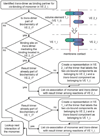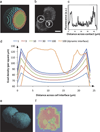Computational modeling of cellular signaling processes embedded into dynamic spatial contexts
- PMID: 22286385
- PMCID: PMC3448286
- DOI: 10.1038/nmeth.1861
Computational modeling of cellular signaling processes embedded into dynamic spatial contexts
Abstract
Cellular signaling processes depend on spatiotemporal distributions of molecular components. Multicolor, high-resolution microscopy permits detailed assessment of such distributions, providing input for fine-grained computational models that explore mechanisms governing dynamic assembly of multimolecular complexes and their role in shaping cellular behavior. However, it is challenging to incorporate into such models both complex molecular reaction cascades and the spatial localization of signaling components in dynamic cellular morphologies. Here we introduce an approach to address these challenges by automatically generating computational representations of complex reaction networks based on simple bimolecular interaction rules embedded into detailed, adaptive models of cellular morphology. Using examples of receptor-mediated cellular adhesion and signal-induced localized mitogen-activated protein kinase (MAPK) activation in yeast, we illustrate the capacity of this simulation technique to provide insights into cell biological processes. The modeling algorithms, implemented in a new version of the Simmune toolset, are accessible through intuitive graphical interfaces and programming libraries.
Figures





Similar articles
-
Key role of local regulation in chemosensing revealed by a new molecular interaction-based modeling method.PLoS Comput Biol. 2006 Jul 21;2(7):e82. doi: 10.1371/journal.pcbi.0020082. Epub 2006 May 25. PLoS Comput Biol. 2006. PMID: 16854213 Free PMC article.
-
Modeling cellular signaling: taking space into the computation.Nat Methods. 2012 Feb 28;9(3):239-42. doi: 10.1038/nmeth.1900. Nat Methods. 2012. PMID: 22373909 Free PMC article.
-
Computational modeling of signaling networks for eukaryotic chemosensing.Methods Mol Biol. 2009;571:507-26. doi: 10.1007/978-1-60761-198-1_33. Methods Mol Biol. 2009. PMID: 19763988
-
Rule-based modeling of signal transduction: a primer.Methods Mol Biol. 2012;880:139-218. doi: 10.1007/978-1-61779-833-7_9. Methods Mol Biol. 2012. PMID: 23361986 Review.
-
Computational Modeling of the Dynamics of Spatiotemporal Rho GTPase Signaling: A Systematic Review.Methods Mol Biol. 2018;1821:3-20. doi: 10.1007/978-1-4939-8612-5_1. Methods Mol Biol. 2018. PMID: 30062401
Cited by
-
Molecular Mechanisms of the Toll-Like Receptor, STING, MAVS, Inflammasome, and Interferon Pathways.mSystems. 2021 Jun 29;6(3):101128msystems0033621. doi: 10.1128/mSystems.00336-21. Epub 2021 Jun 29. mSystems. 2021. PMID: 34184910 Free PMC article. Review.
-
Recent progress using systems biology approaches to better understand molecular mechanisms of immunity.Semin Immunol. 2013 Oct 31;25(3):201-8. doi: 10.1016/j.smim.2012.11.002. Epub 2012 Dec 11. Semin Immunol. 2013. PMID: 23238271 Free PMC article. Review.
-
Emerging proteomic technologies for elucidating context-dependent cellular signaling events: A big challenge of tiny proportions.Proteomics. 2015 May;15(9):1486-502. doi: 10.1002/pmic.201400448. Epub 2015 Feb 10. Proteomics. 2015. PMID: 25545106 Free PMC article. Review.
-
A systems approach to investigate GPCR-mediated Ras signaling network in chemoattractant sensing.Mol Biol Cell. 2022 Mar 1;33(3):ar23. doi: 10.1091/mbc.E20-08-0545. Epub 2021 Dec 15. Mol Biol Cell. 2022. PMID: 34910560 Free PMC article.
-
Could artificial intelligence revolutionize the development of nanovectors for gene therapy and mRNA vaccines?Nano Today. 2022 Dec;47:101665. doi: 10.1016/j.nantod.2022.101665. Epub 2022 Nov 7. Nano Today. 2022. PMID: 37034382 Free PMC article.
References
-
- Lingwood D, Simons K. Lipid rafts as a membrane-organizing principle. Science. 2010;327:46–50. - PubMed
-
- Kholodenko BN. Four-dimensional organization of protein kinase signaling cascades: the roles of diffusion, endocytosis and molecular motors. J Exp Biol. 2003;206:2073–2082. - PubMed
-
- Delon J, Germain RN. Information transfer at the immunological synapse. Curr Biol. 2000;10:R923–R933. - PubMed
-
- Jones RB, Gordus A, Krall JA, MacBeath G. A quantitative protein interaction network for the ErbB receptors using protein microarrays. Nature. 2006;439:168–174. - PubMed
Publication types
MeSH terms
Grants and funding
LinkOut - more resources
Full Text Sources
Molecular Biology Databases

